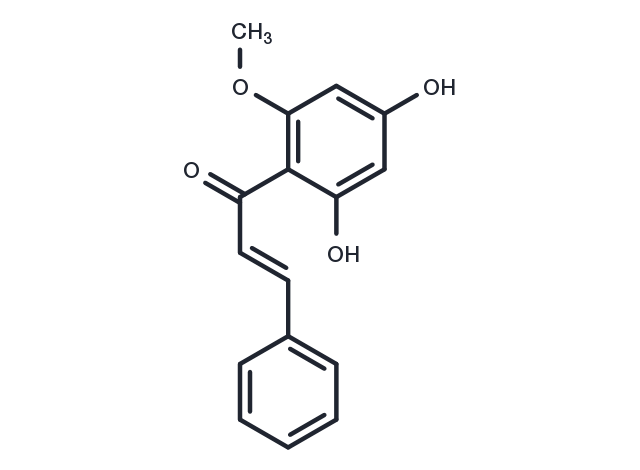Powder: -20°C for 3 years | In solvent: -80°C for 1 year


(E)-Cardamonin (Alpinetin chalcone) is a chalconoid that has been isolated from several plants including Alpinia katsumadai and Alpinia conchigera. It is a novel antagonist of hTRPA1 cation channel with an IC50 of 454 nM. It has received growing attention from the scientific community due to the expectations toward its benefits to human health.

| Pack Size | Availability | Price/USD | Quantity |
|---|---|---|---|
| 10 mg | In stock | $ 30.00 | |
| 25 mg | In stock | $ 55.00 | |
| 50 mg | In stock | $ 79.00 | |
| 100 mg | In stock | $ 117.00 | |
| 500 mg | In stock | $ 283.00 | |
| 1 mL * 10 mM (in DMSO) | In stock | $ 34.00 |



| Description | (E)-Cardamonin (Alpinetin chalcone) is a chalconoid that has been isolated from several plants including Alpinia katsumadai and Alpinia conchigera. It is a novel antagonist of hTRPA1 cation channel with an IC50 of 454 nM. It has received growing attention from the scientific community due to the expectations toward its benefits to human health. |
| Targets&IC50 | TRPA1 (human):454 nM |
| In vitro | Cardamonin selectively blocksTRPA1 activation (IC50=454 nM) while does not interact with TRPV1 nor TRPV4 channel. Docking analysis of cardamonin demonstrates a compatible interaction with A-967079-binding site of TRPA1. Cardamonin does not significantly reduce HEK293 cell viability, nor does it impair cardiomyocyte constriction[1]. Cardamonin suppresses the expression of Tgase-2, cyclooxygenase-2 (COX-2), and p65 (nuclear factor-κB) in a concentration-dependent manner, and restores the expression of IκB in MG63 and Raw264.7 cells[2]. |
| In vivo | Cardamonin (3-30 mg/kg, orally administered) significantly inhibits PBQ-induced writhing. CDN also produces a significant, dose-dependent increase in the withdrawal response latencies in carrageenan-induced hyperalgesia[2]. |
| Cell Research | HEK293 cells are treated with cardamonin (0-90 μM). The cells treated in the absence of the test compound are the negative control. After incubated for 24 h, Cell Titer-Glo reagent is added to the cells and Luminescence is acquired on the plate reader[1]. |
| Synonyms | Alpinetin chalcone, Cardamomin, Cardamonin, (E)-Cardamoni |
| Molecular Weight | 270.28 |
| Formula | C16H14O4 |
| CAS No. | 19309-14-9 |
Powder: -20°C for 3 years | In solvent: -80°C for 1 year
DMSO: 27 mg/mL(100 mM)
You can also refer to dose conversion for different animals. More
bottom
Please see Inhibitor Handling Instructions for more frequently ask questions. Topics include: how to prepare stock solutions, how to store products, and cautions on cell-based assays & animal experiments, etc.
(E)-Cardamonin 19309-14-9 Apoptosis Membrane transporter/Ion channel TRP/TRPV Channel Alpinetin chalcone Cardamomin Inhibitor Transient receptor potential channels (E)Cardamonin Cardamoni (E)-Cardamomin (E) Cardamonin (E)-Alpinetin chalcone Cardamonin (E)-Cardamoni TRP Channel inhibit inhibitor
